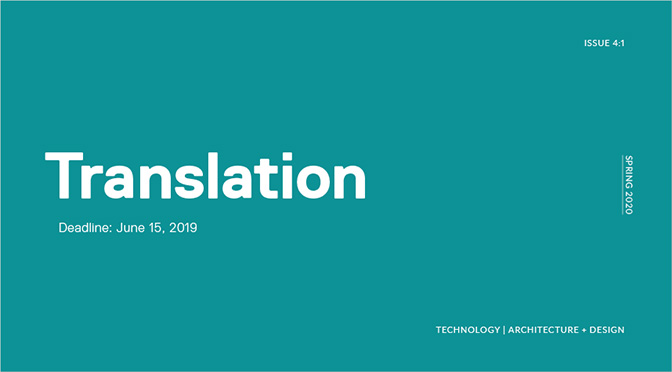TRANSLATION
Submission Deadline: June 15th, 2019
From new design procedures, to the physical testing of materials and production techniques, to alternative construction methods and workflows, the process of advancing an architectural concept from initial idea to full material realization makes use of a broad array of strategies. For its upcoming issue, TAD seeks scholarly submissions, creative design, and primary research that investigate the means by which the design concept becomes translated into the built environment.
Physical testing has long been valued as an aid to concept realization. While digital models and virtual tools provide an affordable and ubiquitous alternative, prototyping remains a powerful means of exploring design options, vetting technologies, rehearsing processes, addressing performance uncertainties, assessing user experience, and gaining stakeholder consensus. Testing prior to and while building have enabled designers to advance construction methods, inform building code development, and initiate new workflows. How are testing methods diversifying, and how are these various methods impacting the design and decision-making processes? TAD invites research projects and papers that investigate the impact of rigorous testing methods on the Translation of ideas into construction.
Investigations of translation benefit from a consideration of the underlying organizational structures that enable architectural production. Throughout the last three decades, the Architecture, Engineering, Construction, and Owner community (AECO) has developed frameworks, certifications, and rating systems in order to contend with the economic, social, environmental, and regulatory contexts in which they must operate. Concurrently, business models, procurement and delivery systems, and contractual agreements have also evolved, creating opportunities to reconceive formats for design services and outputs. Are new organizational forms emerging as a result, and if so, are they leading to transformations in architecture practice and production? How are these practice innovations being implemented and evaluated? Translation invites research that examines both historical and emerging ecologies of practice.
Necessarily, research on translating design concepts into realized projects must take into consideration the emerging technologies of design, construction, and maintenance. The adoption of virtual and augmented reality across AECO sectors, for example, has democratized the design process while increasing support for those who build. Prefabrication and modularization offer the promise of reduced uncertainty surrounding project costs and scheduling. Proliferating methods for collecting project and site data have provided greater fidelity to the interrelationship of labor, design, and construction. How are these and other technologies changing the processes by which design ideas are realized? How are workflows and collaboration among project agents being altered by greater efficiencies in production, streamlined communication, and automation of labor? TAD invites papers and projects that critically interrogate the development, deployment, and impact of the technologies of Translation.
By examining these and related questions, Translation will expand the discourse around developments in the field and assess their implications for future practice. Manuscripts for the double-blind peer review are due before 11:59 pm Eastern Time on Tuesday, June 15, 2019, at TADjournal.org. See TAD Author Guide for manuscript submission requirements.
